“One Night in Miami…”(2020). Cast: Kingsley Ben-Adir, Eli Goree, Aldis Hodge, Leslie Odom Jr., Lance Reddick, Christian Magby, Joaquina Kalukango, Nicolette Robinson, Michael Imperioli, Beau Bridges, Jerome Wilson, Christopher Gorham, Jeremy Pope, Nola Epps, Sean Monaghan, Aaron D. Alexander. Director: Regina King. Screenplay: Kemp Powers. Play: Kemp Powers, One Night in Miami…. Web site. Trailer.
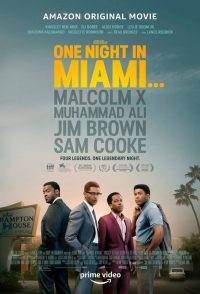
When we commit to achieving a certain goal, we often believe we need to follow a particular path, doing so with unwavering fidelity. In fact, we may become convinced that it’s the only path to be pursued and that it’s the one that everyone similarly committed must follow. But is that really the case? Isn’t it possible that there might be multiple courses of action? Indeed, might that not be especially true if the objective consists of different components that each needs to be achieved in its own way? And wouldn’t denying such an approach lead to potential failure? Those are among the issues debated in the speculative new historical drama, “One Night in Miami….”
On February 25, 1964, the boxing world was stunned when controversial, outspoken but supremely confident underdog Cassius Clay (Eli Goree) upset Sonny Liston (Aaron D. Alexander) to become world heavyweight champion in a title fight in Miami. In the wake of that victory, Clay’s friend and spiritual advisor, Malcolm X (Kingsley Ben-Adir), invited him and their good friends, football great Jim Brown (Aldis Hodge) and singer/music producer Sam Cooke (Leslie Odom), to his hotel for a celebration. Clay, Brown and Cooke were somewhat surprised, however, when they learned they were the only ones invited to what they had expected to be a party. Nevertheless, the meeting of these four extraordinary individuals proved to be quite an occasion, and this film provides a speculative look at what may have transpired.
Why were only four in attendance at this meeting? As Malcolm reveals, he was hoping the occasion would be an opportunity for them to reflect on the future of the emerging civil rights movement. Each of them had become rising stars in their respective fields of endeavor, and Malcolm believed they could make an impact in furthering the cause of rights for African-Americans. Clay, Brown and Cooke had hoped for something a little more festive, a little less serious. But, as events unfolded, their discussion took on an insightful air as each expressed their views on the importance of civil rights and how they might be best achieved. And, given their various temperaments and proposed approaches, their opinions differed, despite a common goal, revealing an underlying divergence with the potential to stop the movement in its tracks and potentially tear it apart.
Malcolm, for example, championed activism, not unlike the kind he had worked to develop through his involvement with the Nation of Islam. Cooke, by contrast, believed that advancement for his people could be best achieved through the cultivation of economic power, something he had done for himself through his successful singing career and the founding of his own record label. Clay and Brown, meanwhile, sought to establish themselves as role models through their athletic pursuits, efforts that they believed could help them create new, broadened opportunities in other areas, such as Brown’s emerging acting career.

As the discussion progresses, however, underlying disagreements emerge. The most heated of these is Malcolm’s criticism of Cooke, contending that the crooner is pandering to White audiences and not using his high-profile platform to draw more attention to the plight of Black Americans. Cooke, by contrast, explains how the establishment and growth of Black-owned enterprises could help the community advance – not necessarily in a “flashy” way, but in one that had substantive impact. Instead of frothy, insipid ballads, Malcolm contends that his friend should be writing and performing songs like Bob Dylan’s Blowin’ in the Wind. Cooke claims there’s no market for protest music and is infuriated by his friend’s criticism, but Malcolm’s comments obviously strike a nerve and give Cooke pause for consideration.
Malcolm’s caustic statements create a rift between him and Cooke, and it prompts him to examine what’s behind his inflammatory remarks. Upon reflection, he admits that he has much on his mind. For instance, he discloses that he and his family are under surveillance by the FBI. He also confesses to the growing discontent he’s been feeling for his association with the Nation of Islam, an organization that he believes has grown out of touch with the followers it claims to serve – and that has quietly placed him under scrutiny for suspected disloyalty. The shadowing that dogs him on two fronts has become so much of a concern that he now has two bodyguards, Kareem (Lance Reddick) and Jamaal (Christian Magby), following him to provide protection.
But the concerns don’t end there. Malcolm also speaks about the establishment of a new organization under his leadership, one that he was hoping could benefit from Clay’s involvement in light of his impending conversion to Islam, a move that would lead him to adopt the new name Muhammad Ali. But, when Clay learns of this, he’s angered – was Malcolm’s intent in converting him to Islam a genuine spiritual gesture or an effort to attract a high-profile spokesperson for this new organization?
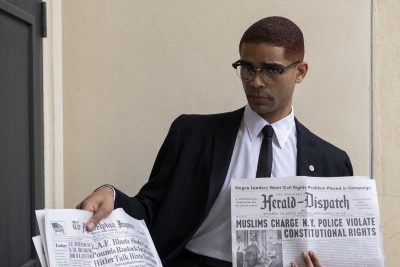
Given the unexpected conflicts that emerge from this meeting, one has to wonder whether everyone would remain friends. What’s more, what would be the fallout from this gathering in terms of its impact on the future of their respective careers and the civil rights movement? Much is obviously at stake on multiple fronts, a turning point through which much could be gained – or lost.
No matter how many films are made about the civil rights movement, it’s a subject that always captivates in light of the magnitude of what transpired. The work of that initiative may not yet be done, but what was accomplished during that dynamic period of achievement in the 1950s and ʼ60s has left a lasting impact on our society and culture, implementing changes that may have once been thought unthinkable but that are today considered fundamental. And that would not have happened were it not for visionaries like the four individuals depicted here.
Having experienced racism firsthand, such as in incidents portrayed at the film’s outset – Cooke performing for a stuffy, unimpressed, all-White audience at New York’s Copacabana and Brown being verbally abused by a bigoted so-called family friend (Beau Bridges) – the protagonists knew full well what it was like to undergo such prejudicial treatment. It was because of what they experienced that they were motivated to move forward with seeking to bring about change. They envisioned a future different from their pasts and worked toward seeing it realized. And this was possible because of their beliefs, the cornerstone of the conscious creation process, the philosophy that maintains we manifest the reality we experience through the power of our thoughts, beliefs and intents. Even if Malcolm, Cooke, Clay and Brown never heard of this doctrine, they certainly mastered its principles, as became apparent through what they achieved in each of their respective areas of accomplishment.
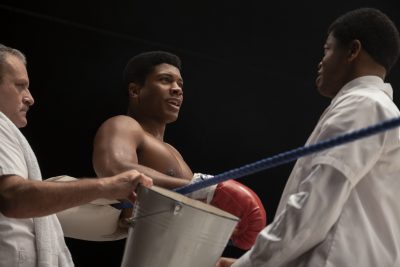
As the film shows, however, such undertakings aren’t always accomplished through single-minded, monolithic courses of action, even if there is a common underlying goal. Indeed, there are often multiple paths to the same destination, and it’s important to recognize this, for, without such an awareness, the prospect of a fractured approach can loom large, threatening to tear apart the overall initiative, as is apparent here. For instance, each of the four principals in this story believed firmly in their respective approaches to achieving success and what these ventures would do for the African-American community, despite the differences in the tactics they each proposed to employ. Because their beliefs (and their faith in them) accounted for the success they attained in their individual endeavors, each of them was convinced that their paths were the “right” ones that everyone should follow.
But is this indeed true? Their respective beliefs obviously worked well for each of them, so isn’t it possible that all of their approaches could work, that all of them could contribute to achieving success in furthering civil rights and benefitting the African-American community? By contrast, isn’t it also possible that arguing over which approach was best – to the exclusion of the others – would lead to a schism in the movement? And who would be served by that?
Several key conscious creation principles could go a long way toward overcoming such an unfortunate scenario. For instance, as a corollary to understanding the multi-path approach to success, it’s helpful to realize that the different approaches are all components of a larger undertaking, one in which each plays a crucial role, even if not readily viewed in such a light. This co-creative effort can work miracles, with each element contributing toward a common goal. By employing a cooperative approach, with suitable beliefs backing each aspect of the plan, it’s possible to realize the desired outcome, with everyone doing his or her part to reach that destination.
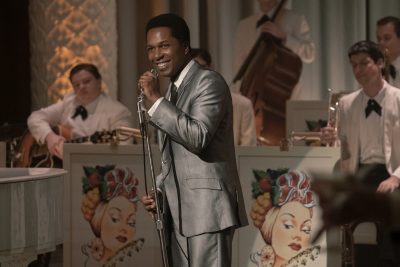
To fulfill the manifestation of each component, the implementation of several other concepts is crucial. For example, it’s important to be authentic with ourselves (and our beliefs). This is one of the most effective ways to materialize what we want, and, in a situation like this, where competing viewpoints might vie for top billing, it’s critical that we remain true to ourselves, despite what other options might cross our paths and attempt to coerce us into pursuing different paths. By sticking to our sense of personal integrity, we can best assure that the manifestations we seek to bring about are truly brought into being. And that’s important, especially where multiple, diverse components are all essential to achieving a particular result.
Sticking to our authenticity often calls upon us to rise above our fears, doubts and limitations, and doing so, in turn, frequently requires us to adjust our beliefs in these areas accordingly. By overcoming what we see as the hindrances that are holding us back (or that we allow to hold us back), we can enable our authenticity to shine through. Again, this is crucial to attain what we seek and to live up to our commitments for participating in these collective ventures.
Should we succeed in these areas, it’s genuinely possible for us to live out our destiny, to engage in our own form of value fulfillment, the conscious creation principle associated with being our best, truest selves for the betterment of ourselves and those around us. There’s no greater goal than this when it comes to the pursuit of our conscious creation efforts, as it exemplifies who we’re meant to be and what we’re intended to accomplish. That’s especially true when it comes to ventures as noble and impactful as realizing civil rights for everyone, and that’s something each of the film’s four principals understood clearly. To achieve that, though, they needed to learn how to straddle the fence that simultaneously allowed them to work together and to be themselves. Admittedly, that may not be a particularly easy course to follow, but, when it’s skillfully envisioned, planned and implemented, truly astounding results are possible. Just look at what’s been accomplished in this area since that fateful night in 1964.
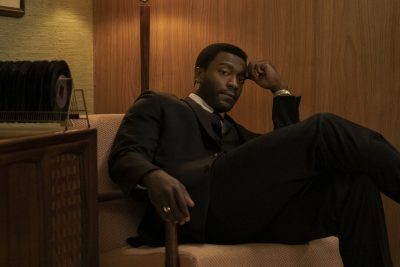
Based on Kemp Powers’s play by the same name, filmmaker Regina King’s directorial debut about this historic 1964 meeting provides a speculative, albeit captivating look at the civil rights movement from the inside. This production presents a balanced examination of the four friends’ views on the subject, including both their areas of concurrence and disagreement and how those pointed opinions had the potential to either tear them apart or bring them together, a sentiment that still rings true today on many societal fronts. The excellent ensemble cast of Ben-Adir, Goree, Hodge and Odom enlivens the superbly penned screenplay, giving the picture a crackling intensity that’s tautly sustained throughout. And, despite a few stagey segments, this is arguably one of the best theatre-to-screen translations I’ve ever seen, effectively opening up the source material and giving it breathing room that such adaptations often lack. King has indeed produced a magnificent work here, handily serving up the right picture for our times, one that gives us all much to ponder in terms of where we are and where we go from here. The film is available for streaming exclusively on Amazon Prime Video.

“One Night in Miami…” has earned the favor of many film critics and captured multiple nominations in multiple awards competitions. As one of the American Film Institute’s Movies of the Year, the picture has already won the National Board of Review Freedom of Expression Award and the Independent Spirit Awards’ Robert Altman Award for best ensemble cast. In addition, this release has earned two Screen Actors Guild Award nods for best cast and best supporting actor (Odom). But it’s through the Critics Choice Award competition where the film has fared best, picking up six nominations for best picture, director, screenplay, ensemble, song and supporting actor (Odom). The film also earned three Golden Globe nods for best director, song and supporting actor (Odom) but took home no statues.
When we’re attempting to pursue a particular goal, the last thing we need to do is to work against ourselves, especially when success depends on relying on the cooperation of others. It’s a time to keep an open mind and consider a variety of possibilities, particularly when the goal is made up of a variety of diverse elements. In those situations, the expertise that others bring to the table through the proficiency of their actions and the formation of their underlying manifesting beliefs should be embraced with open arms and deftly implemented in our collective plans. And, were it not for the adoption of such an approach nearly 60 years ago, there’s no telling where the civil rights movement would be today.
Copyright © 2021, by Brent Marchant. All rights reserved.

No comments:
Post a Comment